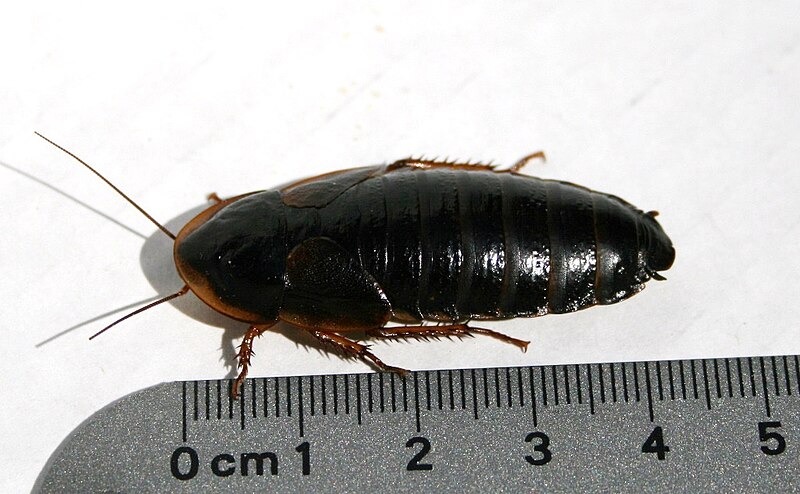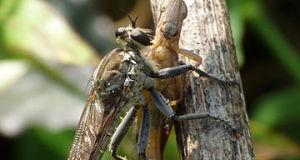Note: Please see Part I and Part 2 for further information on the captive care and natural history of this insect.
Social Grouping
 The orange-spotted roach is sexually dimorphic – males have full wings (but rarely if ever fly), while females have only wing-stubs. A ratio of 1 male per 3-5 females is ideal…excess males should be preferentially used as food for your collection. Maintaining the roaches at this ratio will provide for a great deal of social interaction (please see Part I, Captive Habitat) and increased reproduction.
The orange-spotted roach is sexually dimorphic – males have full wings (but rarely if ever fly), while females have only wing-stubs. A ratio of 1 male per 3-5 females is ideal…excess males should be preferentially used as food for your collection. Maintaining the roaches at this ratio will provide for a great deal of social interaction (please see Part I, Captive Habitat) and increased reproduction.
Males attempt to bluff intruders onto their territories by rising up on their legs and fluttering the wings. If this fails, a shoving match will ensue, with the loser retreating intact (well, except for his pride!).
Captive Longevity
The life cycle is 18 months to 2 years…but this is not well documented. Please keep notes and pass along anything new you might learn.
Reproduction
Fertilization is internal, via a sperm packet deposited by the male. Females produce the typical roach oothecum, or egg case, but retain it internally for a gestation period of approximately 1 month.
The young, 20-30 in number, are born alive and reach sexual maturity in 3-4 months (this varies with temperature and stocking levels).
Miscellaneous
The reduced wing size in female orange-spotted roaches (and similar species) is attributed to paedomorphosis, or the retention of juvenile characteristics, rather than to wing growth inhibition.
Flight muscle is, metabolically, one of the most active of animal tissues, and very “expensive” to support. It is theorized that the resources put into maintaining the flight muscles may, in roaches, take away from reproductive potential. In other words, female roaches are, in essence, “trading” flight for the ability to produce additional eggs. Males of some species are though to retain the power of flight so as to be able to cover more ground when searching for mates.
A description of the journal Cockroach Studies, along with photos of long-winged and wingless species, is posted at:
http://www.nhm.ac.uk/about-us/news/2006/may/news_8129.html
Image referenced from Wikipedia, here.
 That Reptile Blog – Reptile, Amphibian and Exotic Pet Care and Information
That Reptile Blog – Reptile, Amphibian and Exotic Pet Care and Information



Hello Frank.
Interesting observations! I have been raising dubia for about a year now and find them quite interesting in and of themselves. They do however, have some problems. They burrow(and can hide for a long time in an enclosure), nymphs are quite big, and the adults like to play dead when approached by a tarantula so they are less likely to generate a feeding response.
The males, however, are great feeders. It’d be neat if their was something like lateralis, minus their extraordinary speed and infestation possibility.
dubia and other large roaches also make good terrarium critters.
I’ve noticed male rivalry as you’ve described. It is hard to tell but they appear to be guarding territories…though some merely wander around challenging the territory owners. Too many males(such as when all your tarantulas are in premolt!) can result in males with tattered wings/missing legs.
Hello, Joseph…Frank Indiviglio here. Thanks for your interesting comments.
As you say, the roaches are great terrarium subjects…I was most easily able to see what was going on, concerning territoriality and other behavior, when I kept small groups in large enclosures – in crowded “feeder” colonies, its difficult to interpret what I see. Hissing roaches are similar – given enough space, males defend very specific territories, usually centered on a log or other shelter, and supporting 4-6 females.
Strange, sometimes in crowded conditions animals get along better (not roaches…or tarantulas, for that matter!) …but I recall keeping a group of jay thrushes and another of Cuban crocodiles in somewhat crowed holding areas for years with no aggression…when I gave them more room, there were immediate fights, and I lost 2 birds overnight. Very common with cichlids and other fish as well…once there is room for an adequate territory, problems develop. Of course crowding is very stressful, but many species seem to adjust somehow.
Best regards, Frank Indiviglio.
When I first received my Dubia in the mail I thought the next day they were all dying off. Some were looking dead or dying. Then when I went back and looked 10 minutes later they were gone. They were playing dead on me…even if you stay and watch them for a long time they know you are there… it was only when I moved away for a few minutes did they move again!!!
Hello Molly, Frank Indiviglio here.
Thanks very much for the most interesting observation. While I’ve observed that in other insects (i.e. stick insects, various beetles), I cannot recall seeing it in these roaches. I’ve sent an email off to a friend who specializes in roach behavior, to get his thoughts. Please let me know if they continue to do so; great to see someone paying attention to their behavior, and not treating them as a food source only!
Good luck and please keep me posted.
Best regards, Frank Indiviglio.
Hi guys Alex here I’m new to breeding dubia’s but you won’t believe the ammount of reasearch I’ve done and I did find that iif dubia’s get ot of they’re tank/enclosure DON’T WORRY it is impossible for them to survive as it would be way to cold and dry the only exception when you should be worrying is if you happen to live inside a humungous greenhouse.
With regards
Alex
Hello Alex,
Thanks for your in put. There may be concerns in warm climates, certain homes in temperate areas where ideal conditions are maintained for large collections of reptiles, etc, but in general they are not very good at establishing feral colonies. Best, Frank